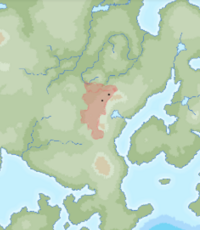Aayan Empire
Aayan Empire Āyana Sāmrājya | |
|---|---|
| from 100s BCE – to 50s CE | |
|
Flag of the Aayan Empire (reconstructed) | |
 Maximum extent of the Aayan Empire, as shown by the location of Nabendu's inscriptions, and visualized by historians: Vincent Arthur Morgan; R. J. Majumdar; and historical geographer Jacksten E. Schlossberg. | |
| Capital |
|
| Government | Absolute Monarchy |
| Today part of | |
The Aayan Empire (Mahanan: Āyana Sāmrājya or आयन साम्राज्य) was an iron-age empire in Oriental Europa, based around the Patuan region of Mahana and Mekabiri. At the empire's greatest extent, it spread from southern Kotowari to northern Mekabiri and west through the great plains of central Europa. The empire was centralised by the first emperor's conquest of the Careleon Plateau.
At any time, the empire was led by an absolute monarch, the emperor. The most famous of these emperors was Emperor Ujesh who established recorded history in Mahana during his religious pilgrimage in 53BC.
Etymology
The word 'Aayan' is believed to have come from the old name 'Āyana' which meant 'Prosperous'. This means that the name Aayan Empire roughly translates to 'Prosperous Empire' in old Gurungi tongue.
History
The Aayan Empire began as Emperor Ujesh managed to form the empire out of anti-Shakyan nobles and powerful houses in western Mahana, around the ancient city of Vaddkewatta which would become the base of government for the empire. The empire was widly popular, appealing to both the Hindu and Gai populations living in the regions through appeasement.
The empire began to expand their territory in 96BCE, with Emperor Ujesh still in power leading the empire down through the Ghobari Valley, seeing little resistance from the Buddhist populations of the region. Tensions rose as the Shakyan Principalities, who occupied the Bay of Bhuram, sent threats directly to Emperor Ujesh. The threats were believed to be made against his life.
